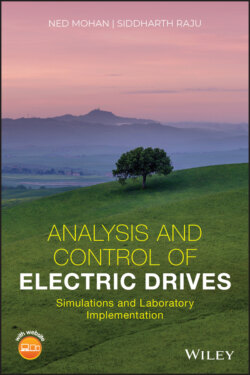Читать книгу Analysis and Control of Electric Drives - Ned Mohan - Страница 40
Solution
ОглавлениеUsing the results of Example 2-2, the combined inertia of the system is
The angular acceleration is
Therefore, from Eq. (2-23),
Fig. 2-7 Motor and load torque interaction with a rigid coupling.
Equation (2-23) shows that the net torque is the quantity that causes acceleration, which in turn leads to changes in speed and position. Integrating the acceleration α(t) with respect to time,
(2-24)
where ωm(0) is the speed at t = 0 and τ is a variable of integration. Further integrating ωm(t) in Eq. (2-24) with respect to time yields
(2-25)
where θ(0) is the position at t = 0 and τ is again a variable of integration. Equations (2-23) through (2-25) indicate that torque is the fundamental variable for controlling speed and position. Equations (2-23) through (2-25) can be represented in a block‐diagram form, as shown in Fig. 2-6b.
